Abstract
Forested buffer strips are typically prescribed around water bodies during forest harvesting operations to minimize effects on aquatic communities and to maintain fish and wildlife habitat. It has been argued that the systematic application of these buffer strips in the boreal forest results in the creation of an unnatural distribution of linear patterns of older-growth forest which is not consistent with the current emulating natural disturbance paradigm. We conducted a multi-year, temporally and spatially controlled, manipulative experiment to investigate the short-term impacts of an alternative practice of riparian partial harvesting and upland clear cutting on breeding and migrating forest birds. Effects on breeding bird community composition were assessed using a modified point counting method. Effects of harvesting on habitat utilization during fall migration were assessed by mist-netting. Breeding bird communities changed significantly post-harvest, but riparian communities diverged less from the pre-harvest condition than upland communities. Populations of early successional/edge species increased post-harvest and forest dependent species declined. Population declines tended to be smaller in the riparian partial cuts than in the upland clear cuts. Capture rates and movement patterns of fall migrants were unaffected by riparian partial harvesting, but catches of Tennessee Warbler (Oreothlypis peregrina), Nashville Warbler (Oreothlypis ruficapilla), Palm Warbler (Setophaga palmarum) and Yellow-rumped Warbler (Setophaga coronata) increased in upland clear cuts. Our results suggest that partial harvesting in riparian reserves may be a viable management option that accommodates the needs of forest dependent birds.
1. Introduction
Riparian forests are recognized as having unique ecological value [1,2,3,4]. In many boreal forest locations, bird communities have higher diversity and abundance in riparian habitats than in upland habitats, e.g., balsam fir—northern white cedar in Quebec [5], spruce, birch, fir mixedwoods in Ontario [6], aspen, poplar spruce mixedwoods in Alberta [7], but not in balsam fir forests in Newfoundland [8]. The higher abundance and diversity of birds near lakes and streams in the boreal forest has been variously attributed to higher insect abundance [6,9] and greater horizontal vegetation diversity [5] in these habitats.
Forested buffer strips are typically prescribed around water bodies during forest harvesting operations to minimize effects on aquatic communities, processes and functions, and to maintain fish and wildlife habitat [2,5,10,11,12,13]. These remnant forest strips provide several potential benefits to forest bird communities. These include maintaining breeding habitat for forest interior and riparian species [13,14,15,16] and providing additional habitat for ubiquitous, generalist and edge-associated species [2,13,15,17,18]. Riparian buffer strips may also function as dispersal and movement corridors [19,20], facilitating landscape connectivity [10], but see [21], and thereby reducing songbird turnover in connected forest patches [22].
It has been argued that the systematic application of no-harvest riparian buffers in the boreal forest results in the creation of an unnatural distribution of linear patterns of older-growth forest concentrated along streams and around lakes [23,24]. This scenario is not consistent with one of the major goals of contemporary forest management, namely to protect forest ecosystems by emulating natural disturbance patterns [25]. Fire is the predominant disturbance agent in the boreal forest [26], and while fires do not avoid riparian areas [27], they do tend to burn less intensely and more variably as they approach water bodies, so that some residual forest overstory is left and gaps of varying size are created along shorelines [28]. Under natural disturbance pattern emulation, alternative riparian management zone configurations are being considered, including the use of partial harvest in riparian areas [13,29,30].
We assessed the impact of partial harvesting on forest birds within riparian buffer strips in a temporally (pre- and post-harvest) and spatially (separate harvest and reference blocks) controlled study design. We evaluated forest bird use of riparian and adjacent upland habitats during the breeding and post-breeding/fall migration periods. We hypothesized that a low level of partial harvesting would alter bird use of riparian habitats, but less so than in adjacent upland clear cuts. Specifically, we hypothesized that (1) riparian and upland breeding bird community composition would change following harvesting, with a shift in dominance from forest-dependent to early successional species; (2) the magnitude of the change would be greater in upland clear cuts than in riparian partial cuts; (3) post-harvest changes in forest bird use of upland clear cuts and riparian partial cuts during the post-breeding/fall migration period would be similar to those observed during the breeding season; and (4) movement patterns of migrants would change in riparian zones after harvesting. Results from this study will allow us to understand the potential impact of partial harvesting of riparian buffer strips as an alternative management option that better reflects patterns generated by natural disturbance.
2. Materials and Methods
2.1. The Study Area and Plot Design
The study was located near White River, Ontario, Canada (Figure 1) in the Superior Section of Canada’s Boreal Forest Region [31]. The largely uninhabited landscape has a rolling-to-broken topography with numerous lakes and drainage systems, and is accessible only by logging and mining roads. The forest is a relatively stable mix of white spruce [Picea glauca (Moench) Voss], balsam fir [Abies balsamea (L.) Mill.], trembling aspen (Populus tremuloides Michx.) and white birch (Betula papyrifera Marsh.), with some black spruce (Picea mariana (Mill.) B.S.P.) and jack pine (Pinus banksiana Lamb.) at higher elevations and in the valleys [31].
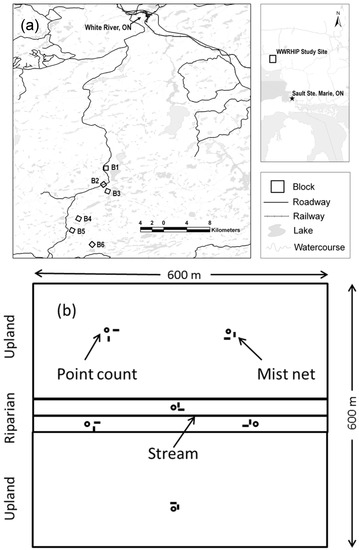
Figure 1.
White River Riparian Harvesting Impacts Project (WWRHIP) experimental design. (a) Location of study blocks near White River, ON, Canada; (b) Schematic of idealized ~36 ha study block, showing sampling locations.
The study was conducted in 3 treated and 3 control blocks, none of which had been logged previously (Figure 1a). Each study block was ~36 ha in size, to accommodate bird sampling, and was centered on a first to third order forest stream (Figure 1b). The 3 treated blocks were contained within larger operational cut blocks (48–77 ha), the upland portions of which were clear cut following provincial guidelines. The riparian buffers in the treated blocks were subjected to an experimental partial cut. As per provincial guidelines, riparian buffer width varied from 30 to 90 m (Table 1), depending primarily on slope. Site selection was constrained by the operational setting. We intentionally used actual forest operations sites to maximize the realism of the forest harvest operations. Blocks were derived from stands designated for harvest in the operational planning, then we adjusted the operational practice (through official, publically-reviewed forest management plan amendment) to accommodate the partial harvesting in riparian buffers. We selected among designated stands for those that included stream reaches with standard riparian buffers to accommodate the partial harvest in buffers. Block B6 and the upland portion of B1 were harvested in March 2004. Block B2 and the riparian portion of B1 were harvested in February 2005. The 3 control blocks (B3, B4 and B5) remained uncut throughout the experiment. The elevations of the 6 blocks ranged from 440 m to 550 m with 40 to 80 m difference between riparian and upland locations in each block.

Table 1.
Details of harvesting in riparian zones of WRRHIP study blocks, White River, ON, Canada. Basal area data are from Holmes et al. [30].
The partial harvest logging prescription in the riparian buffers of B1, B2 and B6 called for the removal of up to 50% of merchantable trees as evenly distributed across species and size classes as possible in accessible portions of the riparian buffers. Feller-buncher operators were instructed to follow 3 rules in choosing which trees to harvest: (1) for every tree of a particular size class removed, one should be left standing; (2) failure to meet the 50% removal objective in one location (i.e., within reach of the feller-buncher) should not be compensated for by harvesting more intensively in another location; and (3) aspen and birch should be removed according to their abundance, regardless of their merchantability. The application of the first 2 rules, along with the challenging terrain (e.g., steep slopes, boulders) ensured that the 50% removal objective was not exceeded at either the local or block levels (Table 1). Access trails for the feller-bunchers were cleared up to 10 m wide. This prescription resulted in a patchy distribution of gaps of varying sizes. Details of the harvest prescription and post-logging assessment are in Holmes et al. [30].
2.2. Bird Sampling
We estimated breeding bird abundances by conducting point counts [32] at 3 riparian sites and 3 upland sites in each block (Figure 1b). Sites were >200 m apart and >100 m from any block boundary. Two point counts were conducted at each site each year from 2003 to 2008. Depending on the year, sampling commenced between 8 June and 15 June, and ended between 22 June and 5 July. Point counts were 10 min in duration and included all birds heard or seen within 50 m of the point count center. A 50-m radius was chosen to minimize the area of upland habitat included in riparian counts, and vice versa. Sampling was restricted to the 4 hours immediately after sunrise, on days when winds were light and there was no rain. At the time of each point count, bird vocalizations were also recorded using a CVX microphone system (Earthsong Series E3A Bio-acoustic Monitor Kit, River Forks Research Corp., Prince Albert, SK, Canada). All of these recordings were interpreted by one of the authors (KAM). The recordings were used to identify unknowns, correct misidentifications, and detect individuals and species that were missed in the field. Based on preliminary tests comparing interpreted and mapped locations of individuals, we were fairly confident in our ability to consistently estimate distances. For each species and year, we calculated point abundance indices by taking the highest count recorded at each point.
We used passive mist-netting to assess bird use of riparian and upland habitats during the (overlapping) late post-breeding and fall migration periods. We sampled 2, 12-m mist nets (30-mm mesh size) at each point count site (Figure 1b). At each site, one mist net was set parallel and the other perpendicular to the watercourse. We divided the late post-breeding period into 3, 2-week intervals between late August and late September or early October. We sampled each block once within each 2-week interval in each year. Nets were opened at official local sunrise and closed 6 h later. We also attempted to mist-net during spring migration in 2003, but were unsuccessful due to persistent high snow depths in the riparian zones.
2.3. Data Analysis
We used Principal Coordinates analysis (PCO; [33]) to describe variation in breeding bird community composition among treatments (logged, undisturbed), locations (upland, riparian), blocks and years. The output of PCO is an ordination of samples in species space based on a matrix of inter-point dissimilarities, in our case Bray-Curtis dissimilarity coefficients constructed from 4th root transformed species’ abundance data. We chose to use the Bray-Curtis coefficient, because it has been shown to outperform other dissimilarity measures in many real-world applications [34]. The 4th root transformation was chosen to down-weight the influence of the more abundant taxa, and thereby focus attention on the whole community, including both common and rare species [35]. Species with total counts of 4 or less were not included in the analysis in order to reduce the potential influence of “sampling error”, where a species is observed sporadically at one location, but not at another, even though it may be present [36]. We used hierarchical agglomerative clustering with group-average linking to display groups of samples based on mutual similarities on the ordination diagrams [37]. We used Spearman correlations to highlight relationships between species’ abundances and ordination axes.
We modeled differences among treatments and years using a permutation-based mixed model analysis of variance (ANOVA; [38]) with 2 fixed factors (Treatment (Tr) and Year (Yr)) and 3 random factors (Location (Lo), either riparian or upland, Block (Bl), nested in treatment, and Site (Si), individual point or mist net, nested in location, block and treatment). Residuals were permuted 999 times under a reduced model. No adjustment was required to deal with repeated measures of sampling units over time, since the permutation procedure generates a correct distribution of the pseudo-F statistic under a true null hypothesis [39]. We assumed that a significant Tr × Yr interaction signaled a significant harvesting effect, and that a significant Lo × Tr × Yr interaction indicated a harvesting effect that differed significantly between riparian and upland locations. In the latter case, the analysis was repeated for riparian and upland locations separately. To identify differences in breeding bird community composition, the analysis was performed on the matrix of Bray-Curtis dissimilarity coefficients used to construct the PCO ordination. To identify differences in counts, the analyses were performed on untransformed matrices of Euclidean distances.
Effects on movement patterns of birds within the riparian zone were modeled in a similar manner with the same two fixed factors as above (Tr and Yr), but with Block, Site and Net-orientation (or, either perpendicular or parallel to the stream) as the random factors.
Rice [40] recommend a sequential Bonferroni procedure to adjust for inflated type-I error rates when analyzing tables containing many simultaneous statistical tests. We feel that sequential Bonferroni is overly conservative, however, and followed the recommendation of Moran [41] to include exact p-values and effect sizes (Cohen’s d) in tables, allowing the reader to decide which differences are biologically meaningful. We calculated Cohen’s d as: MT − MC/σpooled, where MT = mean abundance in treated blocks, MC = mean abundance in control blocks, and σpooled = pooled standard deviation. An effect size of 0.2 is considered small, 0.5 medium and 0.8 large [42].
All statistical analyses were performed using PERMANOVA+ Version 1.0.1 software from PRIMER-E Ltd., Ivybridge, UK. We assumed significance at α < 0.05.
3. Results
3.1. Breeding Season
Harvesting significantly reduced total breeding bird abundance (permutation ANOVA; pTr × Yr = 0.014, Figure 2), but not species richness (pTr × Yr = 0.107, Figure 2). Breeding bird community composition also changed after harvesting (pTr × Yr = 0.002, Figure 3). The effects of harvesting on abundance and community composition did not differ between upland and riparian locations (abundance, pLo × Tr × Yr = 0.695; community composition, pLo × Tr × Yr = 0.214).
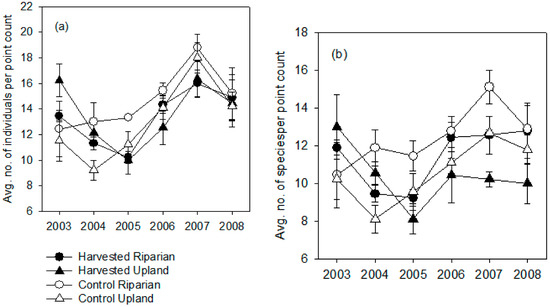
Figure 2.
Changes in (a) total abundance; and (b) species richness in breeding season point counts of WRRHIP avifauna, White River, ON, Canada, 2003–2008. Error bars represent standard errors.
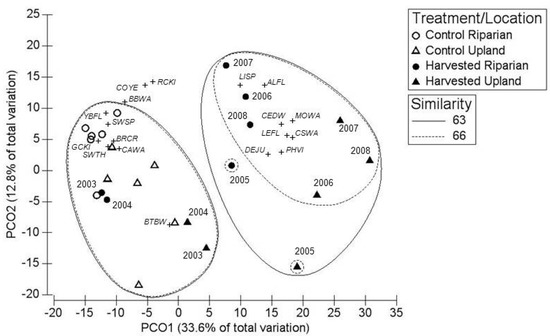
Figure 3.
Principal coordinates analysis of WRRHIP avifauna from point counts, White River, ON, Canada, 2003–2008. Sample locations are based on averages (n = 3) for each treatment × location combination. Sample labels denote year. Samples are grouped by degree of similarity (%) from hierarchical clustering based on the Bray-Curtis dissimilarity matrix used to construct the ordination. Species’ locations on the ordination diagram (denoted by +) are based on Spearman rank correlations between untransformed species’ abundances and PCO axes 1 and 2. YBFL = Yellow-bellied Flycatcher, ALFL = Alder Flycatcher, LEFL = Least Flycatcher, PHVI = Philadelphia Vireo, BRCR = Brown Creeper, GCKI = Golden-crowned Kinglet, RCKI = Ruby-crowned Kinglet, SWTH = Swainson’s Thrush, CEDW = Cedar Waxwing, MOWA = Mourning Warbler, COYE = Common Yellowthroat, BBWA = Bay-breasted Warbler, CSWA = Chestnut-sided Warbler, BTBW = Black-throated Blue Warbler, CAWA = Canada Warbler, LISP = Lincoln’s Sparrow, SWSP = Swamp Sparrow, DEJU = Dark-eyed Junco.
Post-harvest bird communities separated from pre-harvest and control bird communities along the first PCO axis, with the 2 groups diverging at about 63% similarity (Figure 3). This axis appears to represent a gradient of harvesting disturbance. Early-successional and gap species, such as Alder Flycatcher (Empidonax alnorum), Least Flycatcher (Empidonax minimus), Philadelphia Vireo (Vireo philadelphicus), Cedar Waxwing (Bombycilla cedrorum), Mourning Warbler (Geothlypis philadelphia), Chestnut-sided Warbler (Setophaga pensylvanica) and Dark-eyed Junco (Junco hyemalis) were positively associated with this axis, and mature forest species, such as Yellow-bellied Flycatcher (Empidonax flaviventris), Brown Creeper (Certhia americana), Golden-crowned Kinglet (Regulus satrapa), Swainson’s Thrush (Catharus ustulatus), Bay-breasted Warbler (Setophaga castanea) and Canada Warbler (Cardellina canadensis) were negatively associated. The second PCO axis appears to represent a much weaker gradient between drier upland sites toward the negative end of the axis and moist riparian sites toward the positive end (Figure 3). Black-throated Blue Warbler (Setophaga caerulescens) was associated with upland sites, and Alder Flycatcher, Ruby-crowned Kinglet (Regulus calendula), Common Yellowthroat (Geothlypis trichas), Lincoln’s Sparrow (Melospiza lincolnii) and Swamp Sparrow (Melospiza georgiana) with riparian sites.
The largest changes in bird community composition occurred within 1–2 years of harvesting, but the bird communities of harvested upland sites continued to diverge for another 3 years (Figure 3).
Bird community composition varied among blocks (Permutation ANOVA, pBl = 0.043) and years (pYr = 0.001) and there was a significant block by year interaction (pBl × Yr = 0.003). Harvesting affected bird community composition less in block B6 (2006–2008 samples located further to the left on the ordination diagrams) than in either blocks B1 or B2 (Figure 4a,b). Harvesting effects were also smaller (post-harvest samples more similar to controls) in riparian zones than in uplands (Figure 4a,b).
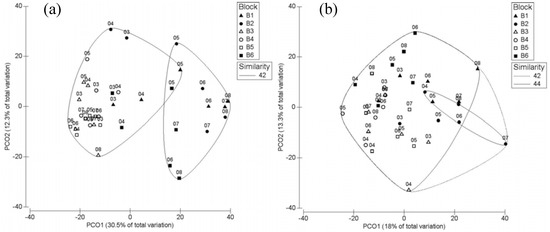
Figure 4.
Principal coordinates analysis of (a) upland; and (b) riparian avifauna in point counts at the WRRHIP study site, White River, ON, Canada, 2003–2008. Sample locations are for individual blocks. Harvested blocks are represented by closed symbols and control blocks by open symbols. Sample labels denote year.
Fourteen species showed a statistically significant response to harvesting in point counts (Table 2), although 4 of these (Blue Jay (Cyanocitta cristata), Boreal Chickadee (Poecile hudsonicus), Tennessee Warbler and Pine Siskin (Spinus pinus)) had relatively small effect sizes (|Cohen’s d| ≤ 0.4). Blue Jay, Boreal Chickadee and Tennessee Warbler also had very small sample sizes (≤31 individual observations, Table 2). Two species responded only to riparian partial cutting (Yellow-bellied Sapsucker (Sphyrapicus varius) and Boreal Chickadee), 3 species only to upland clear cutting (Mourning Warbler, Magnolia Warbler (Setophaga magnolia) and Pine Siskin), and the remaining 9 species (Yellow-bellied Flycatcher, Least Flycatcher, Blue Jay, Cedar Waxwing, Ovenbird (Seiurus aurocapilla), Tennessee Warbler, Blackburnian Warbler (Setophaga fusca), Chestnut-sided Warbler and Yellow-rumped Warbler) to both treatments (Table 2, Figure 5). Some species (e.g., Least Flycatcher, Cedar Waxwing, Mourning Warbler and Chestnut-sided Warbler) clearly benefited from harvesting, while others (e.g., Yellow-bellied Flycatcher, Ovenbird, Magnolia Warbler, Blackburnian Warbler and Yellow-rumped Warbler) were negatively affected (Table 2, Figure 5).

Table 2.
Results of permutation ANOVA on individual species’ abundances and effect sizes (Cohen’s d) for bird species showing a significant harvesting (Treatment × Year) effect in point counts, WRRHIP study site, White River, ON, Canada, 2003–2008.
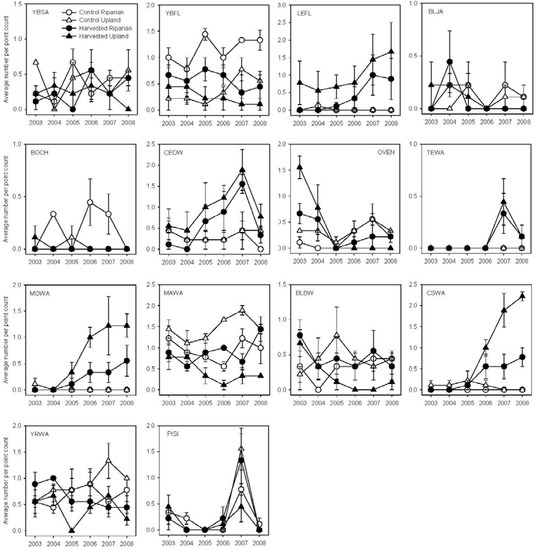
Figure 5.
Changes in individual species’ abundances in point counts at the WRRHIP study site, White River, ON, Canada, 2003–2008. Error bars represent standard errors. YBSA = Yellow-bellied Sapsucker, YBFL = Yellow-bellied Flycatcher, LEFL = Least Flycatcher, GRAJ = Gray Jay, BLJA = Blue Jay, BOCH = Boreal Chickadee, GCKI = Golden-crowned Kinglet, SWTH = Swainson’s Thrush, AMRO = American Robin (Turdus migratorius), CEDW = Cedar Waxwing, OVEN = Ovenbird, TEWA = Tennessee Warbler, NAWA = Nashville Warbler, MOWA = Mourning Warbler, MAWA = Magnolia Warbler, BLBW = Blackburnian Warbler, CSWA = Chestnut-sided Warbler, YRWA = Yellow-rumped Warbler, WTSP = White-throated Sparrow, PISI = Pine Siskin.
3.2. Post-Breeding/Fall Migration
We mist-netted a total of 2392 birds of 64 species, of which 22 were recaptures from a previous year or location. Most species captured had breeding ranges that included our study area. The exceptions were Gray-cheeked Thrush (Catharus minimus), Orange-crowned Warbler (Oreothlypis celata), Blackpoll Warbler (Setophaga striata), American Tree Sparrow (Spizella arborea), Fox Sparrow (Passerella iliaca) and White-crowned Sparrow (Zonotrichia leucophrys), which together accounted for only 41 captures.
Neither harvest treatment had a significant effect on total mist net catch (PERMANOVA, pTr × Yr = 0.349, pLo × Tr × Yr = 0.344; Figure 6). The results did not differ when hatch-year (pTr × Yr = 0.402, pLo × Tr × Yr = 0.260) and after-hatch-year (pTr × Yr = 0.676, pLo × Tr × Yr = 0.505) age classes were analyzed separately. Nashville Warbler, Yellow-rumped Warbler and Western Palm Warbler all increased in post-harvest mist net catches in upland clear cuts (Figure 6, pTr × Yr = 0.060, 0.034 and 0.001, respectively). Catches of Tennessee Warbler also increased, although not significantly (Figure 6, pTr × Yr = 0.399), whereas Ovenbird catches declined (Figure 6, pTr × Yr = 0.009).
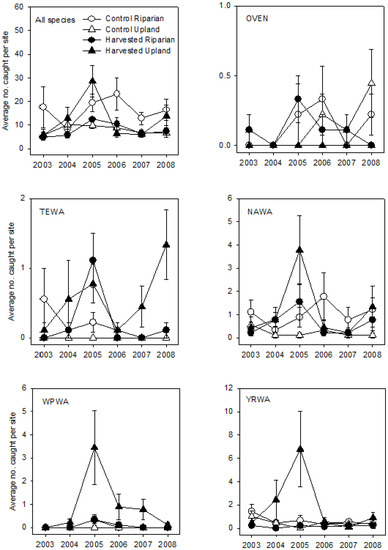
Figure 6.
Number of birds caught in upland and riparian mist nets at the WRRHIP study site, White River, ON, Canada, 2003–2008. Error bars represent standard errors. Only species that demonstrated clear trends are presented. OVEN = Ovenbird, TEWA = Tennessee Warbler, NAWA = Nashville Warbler, WPWA = Western Palm Warbler, YRWA = Yellow-rumped Warbler.
Overall, more birds were caught in riparian mist nets set perpendicular to the stream (mean ± SE = 6.6 ± 0.8) than in nets set parallel to the stream (5.8 ± 0.6), but this difference was not significant. (PERMANOVA, pOr = 0.490). Harvesting had no significant effect on the direction of movement of birds in the riparian zone (Figure 7, pTr × Yr × Or = 0.290).
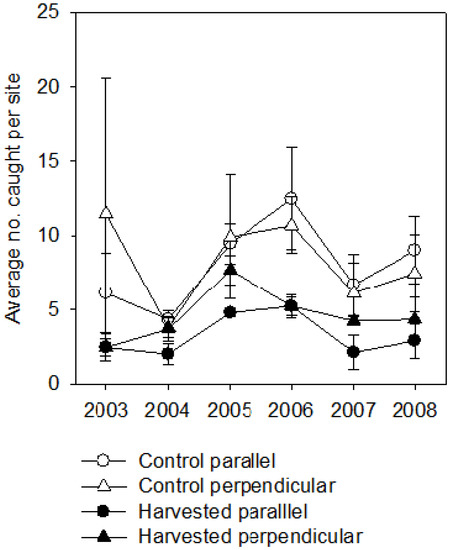
Figure 7.
Number of birds caught in riparian mists nets set parallel and perpendicular to streams at the WRRHIP study site, White River, ON, Canada, 2003–2008. Error bars represent standard error.
4. Discussion
4.1. Breeding Bird Response to Partial Harvesting
In our study, breeding bird communities responded to forest harvesting, but effects were less pronounced in partially harvested riparian reserves than in adjacent upland clear cuts. In both riparian and upland locations, a relatively few species that prefer open woodlands or early successional habitats benefited from harvesting, notably Least Flycatcher, Cedar Waxwing, Mourning Warbler and Chestnut-sided Warbler [43]. A few more species were negatively affected, including Yellow-bellied Sapsucker, Yellow-bellied Flycatcher, Ovenbird, Magnolia Warbler, Blackburnian Warbler and Yellow-rumped Warbler [44,45]. For all but one of the negatively affected species (i.e., Yellow-bellied Flycatcher), declines were smaller in riparian partial cuts than in upland clear cuts.
Total breeding bird abundance declined in our riparian buffer strips after harvest. This is contrary to the results of many other studies in which total avian abundance in buffer strips actually increased post-harvest [10,15,17,45,46,47]. Post-harvest increases in abundance in buffer strips have been attributed to “crowding in” of individuals of mature forest species displaced from nearby clear cuts [10,17,45]. We did not see a crowding effect in our study, possibly because (1) partial harvesting rendered our buffer strips less suitable for forest interior species; or (2) the area surrounding our cut blocks was not as extensively harvested as elsewhere and displaced birds were able to find suitable habitat elsewhere [16]. Alternatively, Marczak et al. [48] suggest that increases in total breeding bird abundance in riparian strips post-harvest may be driven by increases in edge species taking advantage of the availability of high-quality feeding habitat. While populations of early successional/edge species did increase post-harvest in our riparian strips, these were more than offset by the negative effects of partial harvesting on mature forest species.
Our harvest prescription was to remove 50% of the tree basal area from riparian strips, as evenly as possible spatially, and across species and age groups. Due to operational constraints [30], we were only able to achieve a high of 28.5% removal on B2, an intermediate level of 20.5% removal on B1, and a low of 11% removal on B6 (where only one side of the stream was harvested). This difference in harvesting intensity differentially affected breeding bird community composition. In post-harvest samples, block B6 was most similar in community composition to the control blocks, whereas blocks B1 and B2 were less similar. These differences existed, even though residual basal areas were similar across all 3 blocks. Hanowski et al. [47] have suggested that the amount of basal area left remaining in riparian buffers adjacent to clear cut areas will differentially impact breeding bird communities. We agree, but our study also shows that, at least at lower harvesting intensities, the amount of basal area removed may be just as important.
4.2. Caveats to Our Approach
In interpreting our results, it is important to note that we sampled breeding birds within a 50-m fixed radius even though riparian buffer width was frequently less than 50 m. As a result, both riparian species and open-edge species were included in our riparian samples. This approach has both advantages and disadvantages. On the positive side, it probably gives a more accurate picture of the response of early successional/edge species to the creation of a riparian buffer/clear cut edge. If sampling wasn’t extended at all into the clear cut, some of these species and individuals might have been missed. On the other hand, the sampling of clear cut along with partially harvested riparian buffer may have resulted in an overestimation of the response of forest interior species. Whitaker and Montevecchi [15] found that the difference between controls and buffers was more pronounced with the inclusion of observations obtained in clear cut habitats. This difference would presumably increase with increasing area of clear cut sampled. On average, we sampled ~6 m (range 0–10 m) into the clear cuts from the adjacent riparian buffer strip, corresponding to about 5% (range 0–10%) of the total area sampled by a 50-m radius point count.
It is also important to acknowledge potential biases in our estimates of breeding bird abundances. We counted individuals heard within 50 m of point count centers, with no attempt to correct for detectability. The method has two potential problems. First, it is difficult to accurately estimate distances both in the field and on recordings. We attempted to address the latter by taking notes on the locations of individuals at the times the point counts were conducted and referring to these when the recordings were interpreted. In this way, our estimates of distances from the recordings should not be substantially different from those made by our field observers.
The problem of detectability is potentially more serious. It is well known that detection distances vary among species, among human observers and with environmental conditions [49]. In our study, opening up the forest may have increased the detection distance for some species, thereby inflating post-harvest abundance estimates. This potential problem is widely acknowledged, but seldom addressed in field studies [50]. Even assuming that detection probabilities increased post-harvest, the conclusions regarding those species that responded negatively to harvesting should be unaffected, although it is possible that more species might have been included in this group. For those species that responded positively, however, conclusions should be viewed with some caution, especially those where the effect size was relatively small.
One advantage of using our combined field point count/recording method was that a single, very skilled individual could be used to make the final interpretations, correcting mistakes and filling in details that might have been missed in the field. It is well known that differences in physical ability and skill level among point count observers will lead to differences in ability to detect and correctly identify birds by sight and sound [51], and that this inter-observer variability may result in biased estimates of site occupancy and species abundance [52,53]. In our temporally controlled study design, involving multiple observers over the 6 years of the study, we felt it was important to control for this year-to-year inter-observer variability, since “year’ was a crucial factor in determining harvesting impacts. Lastly, our sample sizes were limited with 3 treatment and 3 control blocks, as is common in an operational scale experiment, however we have replication in time within a BACI experiment to offset low sample sizes [54].
4.3. Buffers as Travel Corridors
Although wide buffers provide breeding habitat for many forest bird species (reviewed in [48]), the primary function of narrow buffers is as travel corridors and foraging areas [55]. Partial harvesting within riparian buffers in our study did not appear to diminish their value as movement corridors during the post-breeding/fall migration period, since capture rates and movement patterns within the buffers were unaffected. Contrary to Machtans et al. [19], however, we saw no evidence that the creation of riparian buffer strips actually enhanced movements of dispersing juveniles.
5. Conclusions
It has been suggested that riparian buffer strips are generally too narrow to provide adequate breeding habitat for forest dependent and interior bird species [10,11], although they may contribute to habitat connectivity [19,22]. Since riparian buffers were originally designed to protect aquatic resources, for which the benefits are clear, and only incidentally upland species and habitats [11], current riparian management objectives might be more appropriately focused on water body protection, the conservation of specific riparian habitat features and species, and the creation of movement corridors for aquatic and terrestrial wildlife [25]. The needs of terrestrial fauna, including breeding forest birds, would be better served by setting aside relatively large areas of intact forest containing sensitive habitats and species, regardless of where these might occur on the landscape [7,48]. The loss of wood resulting from the allocation of additional no-harvest conservation reserves could be made up by eliminating or reducing the width of riparian buffers in areas where effects on water quality or quantity would be negligible [7], or by harvesting an equivalent volume of wood from riparian reserves where compatible with conservation objectives [48]. Our study suggests the latter may be a viable alternative, because (1) impacts of partial riparian cuts were relatively minor compared to upland clear cuts; (2) although populations of a number of forest interior bird species did decline in riparian buffer strips post-harvest, no species was eliminated and most had at least begun to recover within 4–5 years; and (3) the value of the buffer strips as movement corridors was not compromised.
Acknowledgments
This research would not have been possible without the hard work and dedication of the many individuals who provided assistance in the field. These were Bruno Benoit, Scott Capell, Will Fick, Juan Gonzalez, Kevin Good, Heather Greenwood, Wendy Kallio, Brian Kutas, Michael O’Connor, Erin Mosley, Mandy Roberts, Marie Thomas, Kerrie Wainio-Keizer and Danica Wetzel. Domtar Inc. was highly supportive of the project and conducted the experimental logging, for which special thanks are due to Kandyd Szuba, Mike Furniss and Robert Lechasseur. Funding was provided by an Ontario Living Legacy Trust Grant #07-018 to SBH and an Enhanced Forest Productivity Science Program Grant #010-2-R1 to DPK.
Author Contributions
S.B.H. and D.P.K. conceived and designed the experiments; S.B.H. and K.A.M. performed the experiments; S.B.H. analyzed the data; all authors wrote the paper; L.A.V. is the corresponding author and will handle all revisions.
Conflicts of Interest
The authors declare no conflict of interest. The funding sources (OLL Trust and EFPS Program) and Domtar Inc. had no involvement in the design of the study; in the collection, analysis, and interpretation of data; in the writing of the report; or in the decision to submit the paper for publication.
References
- Naiman, R.J.; Decamps, H.; Pollock, M. The role of riparian corridors in maintaining regional biodiversity. Ecol. Appl. 1993, 3, 209–212. [Google Scholar] [CrossRef] [PubMed]
- Pearson, S.F.; Giovanini, J.; Jones, J.E.; Kroll, A.J. Breeding bird community continues to colonize riparian buffers ten years after harvest. PLoS ONE 2015, 10, e0143241. [Google Scholar] [CrossRef] [PubMed]
- Bennett, A.F.; Nimmo, D.G.; Radford, J.Q. Riparian vegetation has disproportionate benefits for landscape-scale conservation of woodland birds in highly modified environments. J. Appl. Ecol. 2014, 51, 514–523. [Google Scholar] [CrossRef]
- Perry, R.W.; Wigley, T.B.; Melchiors, M.A.; Thill, R.E.; Tappe, P.A.; Miller, D.A. Width of riparian buffer and structure of adjacent plantations influence occupancy of conservation priority birds. Biodivers. Conserv. 2011, 20, 625–642. [Google Scholar] [CrossRef]
- LaRue, P.; Belanger, L.; Huot, J. Riparian edge effects on boreal balsam fir bird communities. Can. J. For. Res. 1995, 25, 555–566. [Google Scholar] [CrossRef]
- Mosley, E.; Holmes, S.B.; Nol, E. Songbird diversity and movement in upland and riparian habitats in the boreal mixedwood forest of northeastern Ontario. Can. J. For. Res. 2006, 36, 1149–1164. [Google Scholar] [CrossRef]
- Macdonald, S.E.; Eaton, B.; Machtans, C.S.; Paszkowski, C.A.; Hannon, S.J.; Boutin, S. Is forest close to lakes ecologically unique? Analysis of vegetation, small mammals, amphibians and songbirds. For. Ecol. Manag. 2006, 223, 1–17. [Google Scholar] [CrossRef]
- Whitaker, D.M.; Montevecchi, W.A. Breeding bird assemblages associated with riparian, interior forest, and nonriparian edge habitats in a balsam fir ecosystem. Can. J. For. Res. 1997, 27, 1159–1167. [Google Scholar] [CrossRef]
- Whitaker, D.M.; Carroll, A.L.; Montevecchi, W.A. Elevated numbers of flying insects and insectivorous birds in riparian buffer strips. Can. J. Zool. 2000, 78, 740–747. [Google Scholar] [CrossRef]
- Hannon, S.J.; Paszkowski, C.A.; Boutin, S.; DeGroot, J.; Macdonald, S.E.; Wheatley, M.; Eaton, B.R. Abundance and species composition of amphibians, small mammals, and songbirds in riparian forest buffer strips of varying widths in the boreal mixedwood of Alberta. Can. J. For. Res. 2002, 32, 1784–1800. [Google Scholar] [CrossRef]
- Lee, P.; Smyth, C.; Boutin, S. Quantitative review of riparian buffer width guidelines from Canada and the United States. J. Environ. Manag. 2004, 70, 165–180. [Google Scholar] [CrossRef]
- Naiman, R.J.; Decamps, H.; McClain, M.E. Riparia: Ecology, Conservation, and Management of Streamside Communities; Elsevier Academic Press: San Diego, CA, USA, 2005. [Google Scholar]
- Kardynal, K.J.; Morissette, J.L.; Van Wilgenburg, S.L.; Bayne, E.M.; Hobson, K.A. Avian responses to experimental harvest in southern boreal mixedwood shoreline forests: Implications for riparian buffer management. Can. J. For. Res. 2011, 41, 2375–2388. [Google Scholar] [CrossRef]
- Meiklejohn, B.A.; Hughes, J.W. Bird communities in riparian buffer strips of industrial forests. Am. Midl. Nat. 1999, 141, 172–184. [Google Scholar] [CrossRef]
- Whitaker, D.M.; Montevecchi, W.A. Breeding bird assemblages inhabiting riparian buffer strips in Newfoundland, Canada. J. Wildl. Manag. 1999, 63, 167–179. [Google Scholar] [CrossRef]
- Lambert, J.D.; Hannon, S.J. Short-term effects of timber harvest on abundance, territory characteristics, and pairing success of ovenbirds in riparian buffer strips. Auk 2000, 117, 687–698. [Google Scholar] [CrossRef]
- Darveau, M.; Beauchesne, P.; Belanger, L.; Huot, J.; LaRue, P. Riparian forest strips as habitat for breeding birds in boreal forest. J. Wildl. Manag. 1995, 59, 67–78. [Google Scholar] [CrossRef]
- Pearson, S.F.; Manuwal, D.A. Breeding bird response to riparian buffer width in managed Pacific northwest douglas-fir forests. Ecol. Appl. 2001, 11, 840–853. [Google Scholar] [CrossRef]
- Machtans, C.S.; Villard, M.A.; Hannon, S.J. Use of riparian buffer strips as movement corridors by forest birds. Conserv. Biol. 1996, 10, 1366–1379. [Google Scholar] [CrossRef]
- Robichaud, I.; Villard, M.A.; Machtans, C.S. Effects of forest regeneration on songbird movements in a managed forest landscape of Alberta, Canada. Landsc. Ecol. 2002, 17, 247–262. [Google Scholar] [CrossRef]
- Hannon, S.J.; Schmiegelow, F.K.A. Corridors may not improve the conservation value of small reserves for most boreal birds. Ecol. Appl. 2002, 12, 1457–1468. [Google Scholar] [CrossRef]
- Schmiegelow, F.K.A.; Machtans, C.S.; Hannon, S.J. Are boreal birds resilient to forest fragmentation? An experimental study of short-term community responses. Ecology 1997, 78, 1914–1932. [Google Scholar] [CrossRef]
- Buttle, J.M. Rethinking the donut: The case for hydrologically relevant buffer zones. Hydrol. Process. 2002, 16, 3093–3096. [Google Scholar] [CrossRef]
- Dragotescu, I.; Kneeshaw, D.D. A comparison of residual forest following fires and harvesting in boreal forests in Quebec, Canada. Silva Fenn. 2012, 46, 365–376. [Google Scholar] [CrossRef]
- Macdonald, S.E.; Burgess, C.J.; Scimgeour, G.J.; Boutin, S.; Reedyk, S.; Kotak, B. Should riparian buffers be part of forest management based on emulation of natural disturbances? For. Ecol. Manag. 2004, 187, 185–196. [Google Scholar] [CrossRef]
- Johnson, E.A. Fire and Vegetation Dynamics: Studies from the North American Boreal Forest; Cambridge University Press: Cambridge, UK, 1992. [Google Scholar]
- Andison, D.W.; McCleary, K. Disturbance in Riparian Zones on Foothills and Mountain Landscapes of Alberta; Foothills Model Forest: Hinton, AB, Canada, 2002; p. 40. [Google Scholar]
- Nitschke, C.R. Does forest harvesting emulate fire disturbance? A comparison of effects on selected attributes in coniferous-dominated headwater systems. For. Ecol. Manag. 2005, 214, 305–319. [Google Scholar] [CrossRef]
- Kardynal, K.J.; Hobson, K.A.; Van Wilgenburg, S.L.; Morissette, J.L. Moving riparian management guidelines towards a natural disturbance model: An example using boreal riparian and shoreline forest bird communities. For. Ecol. Manag. 2009, 257, 54–65. [Google Scholar] [CrossRef]
- Holmes, S.B.; Kreutzweiser, D.P.; Hamilton, P.S. Operational and economic feasibility of logging within forested riparian zones. For. Chron. 2010, 86, 601–607. [Google Scholar] [CrossRef]
- Rowe, J.S. Forest Regions of Canada; Canadian Forestry Service: Ottawa, ON, Canada, 1972. [Google Scholar]
- Ralph, C.J.; Droege, S.; Sauer, J.R. Managing and monitoring birds using point counts: Standards and applications. In Monitoring Bird Populations by Point Counts; Ralph, C.J., Sauer, J.R., Droege, S., Eds.; United States Department of Agriculture Forest Service: Albany, CA, USA, 1995; pp. 171–175. [Google Scholar]
- Legendre, P.; Legendre, L. Numerical Ecology, 2nd ed.; Elsevier Science B.V.: Amsterdam, The Netherlands, 1998. [Google Scholar]
- Clarke, K.R.; Somerfield, P.J.; Chapman, M.G. On resemblance measures for ecological studies, including taxonomic dissimilarities and a zer-adjusted bray-curtis coefficient for denuded assemblages. J. Exp. Mar. Biol. Ecol. 2006, 330, 55–80. [Google Scholar] [CrossRef]
- Clarke, K.R.; Warwick, R.M. Change in Marine Communities: An Approach to Statistical Analysis and Interpretation, 2nd ed.; PRIMER-E: Plymouth, UK, 2001. [Google Scholar]
- Legendre, P.; Gallagher, E.D. Ecologically meaningful transformations for ordination of species data. Oecologia 2001, 129, 271–281. [Google Scholar] [CrossRef]
- Cormack, R.M. A review of classification. J. R. Stat. Soc. Ser. A 1971, 134, 321–367. [Google Scholar] [CrossRef]
- Anderson, M.J. A new method for non-parametric mutlivariate analysis of variance. Austral Ecol. 2001, 26, 32–46. [Google Scholar]
- Anderson, M.J.; Gorley, R.N.; Clarke, K.R. Permanova + for Primer: Guide to Software and Statistical Methods; PRIMER-E Ltd.: Plymount, UK, 2008; p. 214. [Google Scholar]
- Rice, W.R. Analyzing tables of statistical tests. Evolution 1989, 43, 223–225. [Google Scholar] [CrossRef]
- Moran, M.D. Arguments for rejecting the sequential bonferroni in ecological studies. Oikos 2003, 100, 403–405. [Google Scholar] [CrossRef]
- Cohen, J. Statistical Power Analysis for the Behavioral Sciences; Lawrence Earlbaum Associates Inc.: Hillsdale, NJ, USA, 1988. [Google Scholar]
- Chizinski, C.J.; Peterson, A.; Hanowski, J.; Blinn, C.; Vondracek, B.; Niemi, G. Breeding bird response to partially harvested riparian management zones. For. Ecol. Manag. 2011, 261, 1892–1900. [Google Scholar] [CrossRef]
- Johnson, W.N., Jr.; Brown, P.W. Avian use of a lakeshore buffer strip and an undisturbed lakeshore in maine. North. J. Appl. For. 1990, 7, 114–117. [Google Scholar]
- Hanowski, J.; Danz, N.; Lind, J.; Niemi, G. Breeding bird response to riparian harvest and harvest equipment. For. Ecol. Manag. 2003, 174, 315–328. [Google Scholar] [CrossRef]
- Hanowski, J.; Danz, N.; Lind, J. Breeding bird response to riparian forest managment: 9 years post-harvest. For. Ecol. Manag. 2007, 241, 272–277. [Google Scholar] [CrossRef]
- Hanowski, J.; Danz, N.; Lind, J.; Niemi, G. Breeding bird response to varying amounts of basal area retention in riparian buffers. J. Wildl. Manag. 2005, 69, 689–698. [Google Scholar] [CrossRef]
- Marczak, L.B.; Sakamaki, T.; Turvey, S.L.; Deguise, I.; Wood, S.L.R.; Richardson, J.S. Are forest buffers an effective conservation strategy for riparian fauna? An assessment using meta-analysis. Ecol. Appl. 2010, 20, 126–134. [Google Scholar] [CrossRef] [PubMed]
- Celis-Murillo, A.; Deppe, J.L.; Allen, M.F. Using soundscape recordings to estimate bird species abundance, richness, and composition. J. Field Ornithol. 2009, 80, 64–78. [Google Scholar] [CrossRef]
- Anderson, M.J. The need to get the basics right in wildlife fiedl studies. Wildl. Soc. Bull. 2001, 29, 1294–1297. [Google Scholar]
- Rempel, R.S.; Hobson, K.A.; Holborn, G.; Van Wilgenburg, S.L.; Elliott, J. Bioacoustic monitoring of forest songbirds: Interpreter variability and effects of configuration and digital processing methods in the laboratory. J. Field Ornithol. 2005, 76, 1–11. [Google Scholar] [CrossRef]
- Hutto, R.L.; Stutzman, R.J. Human versus autonomous recording units: A comparison of point-count results. J. Field Ornithol. 2009, 80, 387–398. [Google Scholar] [CrossRef]
- Campbell, M.; Frnacis, C.M. Using stereo-microphones to evaluate observer variation in North American breeding bird survey point counts. Auk 2011, 128, 303–312. [Google Scholar] [CrossRef]
- Smith, E.P.; Orvos, D.R.; Cairns, J., Jr. Impact assessment using the Before-After-Control-Impact (BACI) model: Concerns and comments. Can. J. Fish. Aquat. Sci. 1993, 50, 627–637. [Google Scholar] [CrossRef]
- Shirley, S.M.; Smith, J.N.M. Bird community structure across riparian buffer strips of varying width in a coastal temperate forest. Biol. Conserv. 2005, 125, 475–489. [Google Scholar] [CrossRef]
© 2017 by the authors. Licensee MDPI, Basel, Switzerland. This article is an open access article distributed under the terms and conditions of the Creative Commons Attribution (CC BY) license (http://creativecommons.org/licenses/by/4.0/).